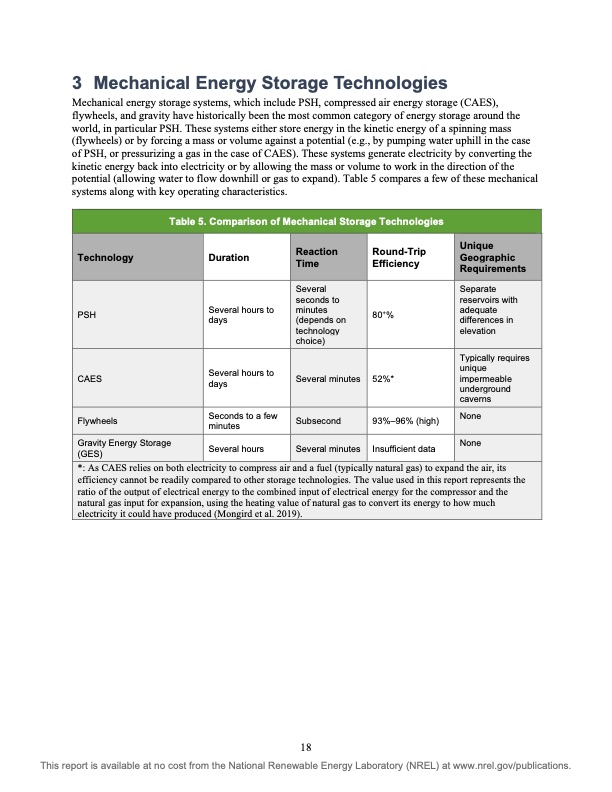
PDF Publication Title:
Text from PDF Page: 025
3 MechanicalEnergyStorageTechnologies Mechanical energy storage systems, which include PSH, compressed air energy storage (CAES), flywheels, and gravity have historically been the most common category of energy storage around the world, in particular PSH. These systems either store energy in the kinetic energy of a spinning mass (flywheels) or by forcing a mass or volume against a potential (e.g., by pumping water uphill in the case of PSH, or pressurizing a gas in the case of CAES). These systems generate electricity by converting the kinetic energy back into electricity or by allowing the mass or volume to work in the direction of the potential (allowing water to flow downhill or gas to expand). Table 5 compares a few of these mechanical systems along with key operating characteristics. Table 5. Comparison of Mechanical Storage Technologies Technology Duration Reaction Time Round-Trip Efficiency Unique Geographic Requirements PSH Several hours to days Several seconds to minutes (depends on technology choice) 80+% Separate reservoirs with adequate differences in elevation CAES Several hours to days Several minutes 52%* Typically requires unique impermeable underground caverns Flywheels Seconds to a few minutes Subsecond 93%–96% (high) None Gravity Energy Storage (GES) Several hours Several minutes *: As CAES relies on both electricity to compress air and a fuel (typically natural gas) to expand the air, its efficiency cannot be readily compared to other storage technologies. The value used in this report represents the ratio of the output of electrical energy to the combined input of electrical energy for the compressor and the natural gas input for expansion, using the heating value of natural gas to convert its energy to how much electricity it could have produced (Mongird et al. 2019). Insufficient data None 18 This report is available at no cost from the National Renewable Energy Laboratory (NREL) at www.nrel.gov/publications.PDF Image | USAID GRID-SCALE ENERGY STORAGE TECHNOLOGIES PRIMER

PDF Search Title:
USAID GRID-SCALE ENERGY STORAGE TECHNOLOGIES PRIMEROriginal File Name Searched:
76097.pdfDIY PDF Search: Google It | Yahoo | Bing
Turbine and System Plans CAD CAM: Special for this month, any plans are $10,000 for complete Cad/Cam blueprints. License is for one build. Try before you buy a production license. More Info
Waste Heat Power Technology: Organic Rankine Cycle uses waste heat to make electricity, shaft horsepower and cooling. More Info
All Turbine and System Products: Infinity Turbine ORD systems, turbine generator sets, build plans and more to use your waste heat from 30C to 100C. More Info
CO2 Phase Change Demonstrator: CO2 goes supercritical at 30 C. This is a experimental platform which you can use to demonstrate phase change with low heat. Includes integration area for small CO2 turbine, static generator, and more. This can also be used for a GTL Gas to Liquids experimental platform. More Info
Introducing the Infinity Turbine Products Infinity Turbine develops and builds systems for making power from waste heat. It also is working on innovative strategies for storing, making, and deploying energy. More Info
Need Strategy? Use our Consulting and analyst services Infinity Turbine LLC is pleased to announce its consulting and analyst services. We have worked in the renewable energy industry as a researcher, developing sales and markets, along with may inventions and innovations. More Info
Made in USA with Global Energy Millennial Web Engine These pages were made with the Global Energy Web PDF Engine using Filemaker (Claris) software.
Sand Battery Sand and Paraffin for TES Thermo Energy Storage More Info
| CONTACT TEL: 608-238-6001 Email: greg@infinityturbine.com | RSS | AMP |